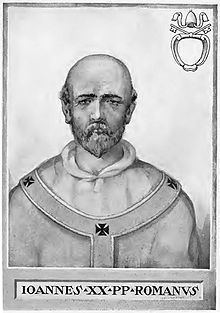Papacy began May 1024 Name Pope XIX Birth name Romanus Siblings Pope Benedict VIII | Papacy ended October 1032 | |
 | ||
Parents Maria di Tuscolo, Gregory I, Count of Tusculum | ||
Grandparents Alberic II of Spoleto | ||
Pope John XIX | Wikipedia audio article
Pope John XIX (Latin: Ioannes XIX; died October 1032) was Pope from May 1024 to his death in 1032.
Born Romanus in Rome as the son of Gregory I, Count of Tusculum, he succeeded his brother Pope Benedict VIII, both members of the powerful house of Tusculum. Prior to being elected Pope, he was an unordained layman and was therefore ordained a bishop in order to enable him to ascend the papal chair, having previously been a consul and senator.
He played a role in the process leading to the Schism of 1054 by rejecting a proposal by Patriarch Eustathius of Constantinople to recognise that Patriarchate's sphere of interest in the east. Against the grain of ecclesiastical history, John XIX agreed, upon being paid a large bribe, to grant the title of ecumenical bishop to the Patriarch of Constantinople. However, this proposal excited general indignation throughout the Church, compelling him almost immediately to withdraw from the agreement.
On the death of the Emperor Henry II in 1024, he gave his support to Emperor Conrad II, who along with his consort was crowned with great pomp at St. Peter's Basilica on Easter of 1027.
In 1025 he sent the crown to Poland and blessed the coronation of the Polish king Bolesław I the Brave.
On 6 April 1027, John held a Lateran synod in which he declared for the Patriarch of Aquileia against the Patriarch of Grado, giving its bishop, Poppo of Aquileia, the patriarchal dignity and putting the bishop of Grado under his jurisdiction. In fact, the patriarch took precedence over all Italian bishops. In 1029, John revoked his decision and reaffirmed all the dignities of Grado. John also enacted a Papal Bull endowing Byzantius, Archbishop of Bari, with the right to consecrate his own twelve suffragans after the reattachment of the Bariot diocese to Rome in 1025. This was part of a conciliatory agreement with Eustathius, whereby the existence of the Byzantine Rite would be allowed in Italy in exchange for the establishment of Latin Rite churches in Constantinople.
He was said to have been killed by a mob of angry peasants, but there is no evidence to support this. The actual cause of death is unknown.
After John XIX's death, his nephew Pope Benedict IX was found as a successor, although he was still young; according to some sources, he was only 12, but he was more likely to have been about 18 or 20.
The next Pope named John was Pope John XXI (1276–77); there is no Pope John XX (see article on John XX for an explanation).
